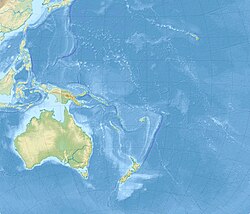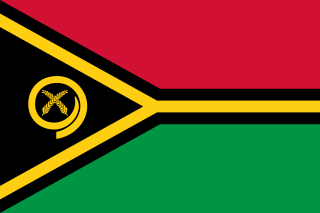
Vanuatu, officially the Republic of Vanuatu, is an island country located in the South Pacific Ocean. The archipelago, which is of volcanic origin, is 1,750 km (1,090 mi) east of northern Australia, 540 km (340 mi) northeast of New Caledonia, east of New Guinea, southeast of Solomon Islands, and west of Fiji.
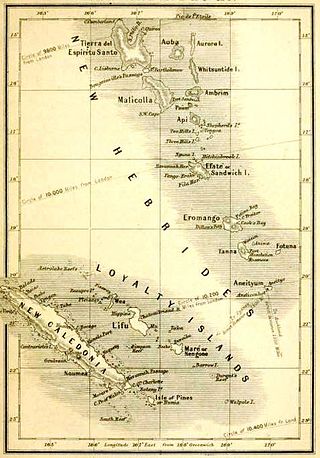
The history of Vanuatu spans over 3,200 years.

A World Heritage Site is a landmark or area with legal protection by an international convention administered by the United Nations Educational, Scientific and Cultural Organization (UNESCO). World Heritage Sites are designated by UNESCO for having cultural, historical, scientific or other form of significance. The sites are judged to contain "cultural and natural heritage around the world considered to be of outstanding value to humanity".

Port Vila, or simply Vila, is the capital and largest city of Vanuatu. It is located on the island of Efate.
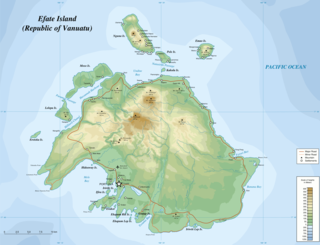
Efate is an island in the Pacific Ocean which is part of the Shefa Province in Vanuatu. It is also known as Île Vate.
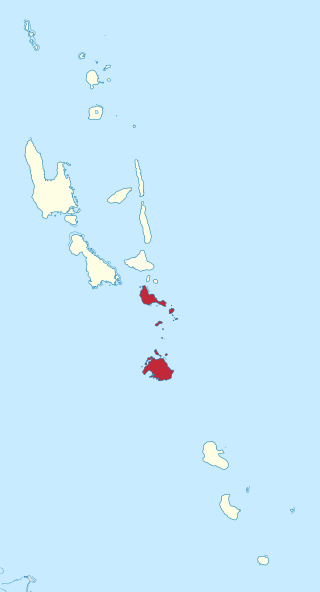
Shefa is one of the six provinces of Vanuatu, located in the center of the country and including the islands of Epi and Efate and the Shepherd Islands. The province's name is derived from the initial letters of SHepherd and EFAte. It has a population of 78,723 people and an area of 1,455 km2. Its capital is Port Vila, which is also the capital of the nation.

Tourism is an important sector for Philippine economy. The travel and tourism industry contributed 5.2%% to the country's GDP in 2021; this was lower than the 12.7% recorded in 2019 prior to the COVID-19 lockdowns. The country is known for having its rich biodiversity as its main tourist attraction. Popular destinations among tourists include Boracay, Palawan, and Siargao. Despite potential, the Philippines has lagged in tourism industry behind some of its Southeast Asian neighbors due to political and social problems.

Ureparapara is the third largest island in the Banks group of northern Vanuatu, after Gaua and Vanua Lava.
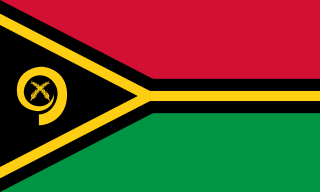
The following outline is provided as an overview of and topical guide to Vanuatu:

Ralph John Regenvanu is a Ni-Vanuatu anthropologist, artist and politician. He has been a Member of Parliament since September 2008, was a member of Cabinet for most of the period from December 2010 to January 2012 and then from March 2013 to June 2015, and was the Director of the Vanuatu National Cultural Council from 1995 until December 2010.

The National Museum of Vanuatu is located in the Vanuatu Cultural Centre (VCC) in Port Vila, Vanuatu. It specializes in exhibits relating to the culture and history of this group of islands in the South Pacific. It is unique amongst Pacific national cultural institutions for rejecting many aspects of European museology, and creating new ways of working which value kastom practices.

Australian Convict Sites is a World Heritage property consisting of 11 remnant penal sites originally built within the British Empire during the 18th and 19th centuries on fertile Australian coastal strips at Sydney, Tasmania, Norfolk Island, and Fremantle; now representing "...the best surviving examples of large-scale convict transportation and the colonial expansion of European powers through the presence and labour of convicts."

Lelepa is an island in the southwestern Pacific island nation of Vanuatu. It is located off the northwest coast of the island of Efate.

Oceanian culture encompasses the collective and diverse customs and traditions of art, architecture, music, literature, lifestyle, philosophy, politics and religion that have been practiced and maintained by the numerous ethnic groups of the geographical region of Oceania since prehistory. Cultures of Oceania reflect not only that of the region's indigenous peoples, but those cultures that followed European colonisation as well; and the United States, particularly via mass culture such as cinema and TV. Oceania is commonly divided into four geographic sub-regions, that are characterized by perceivable commonalities, like culture, religion, language and relative ethnic (racial) homogeneity. These regions are Australasia, Melanesia, Micronesia, and Polynesia.

Eretoka is a small uninhabited island in Shefa Province of Vanuatu in the Pacific Ocean. The island lies off the western coast of Efate Island. There is a lighthouse built in the 1960s.


